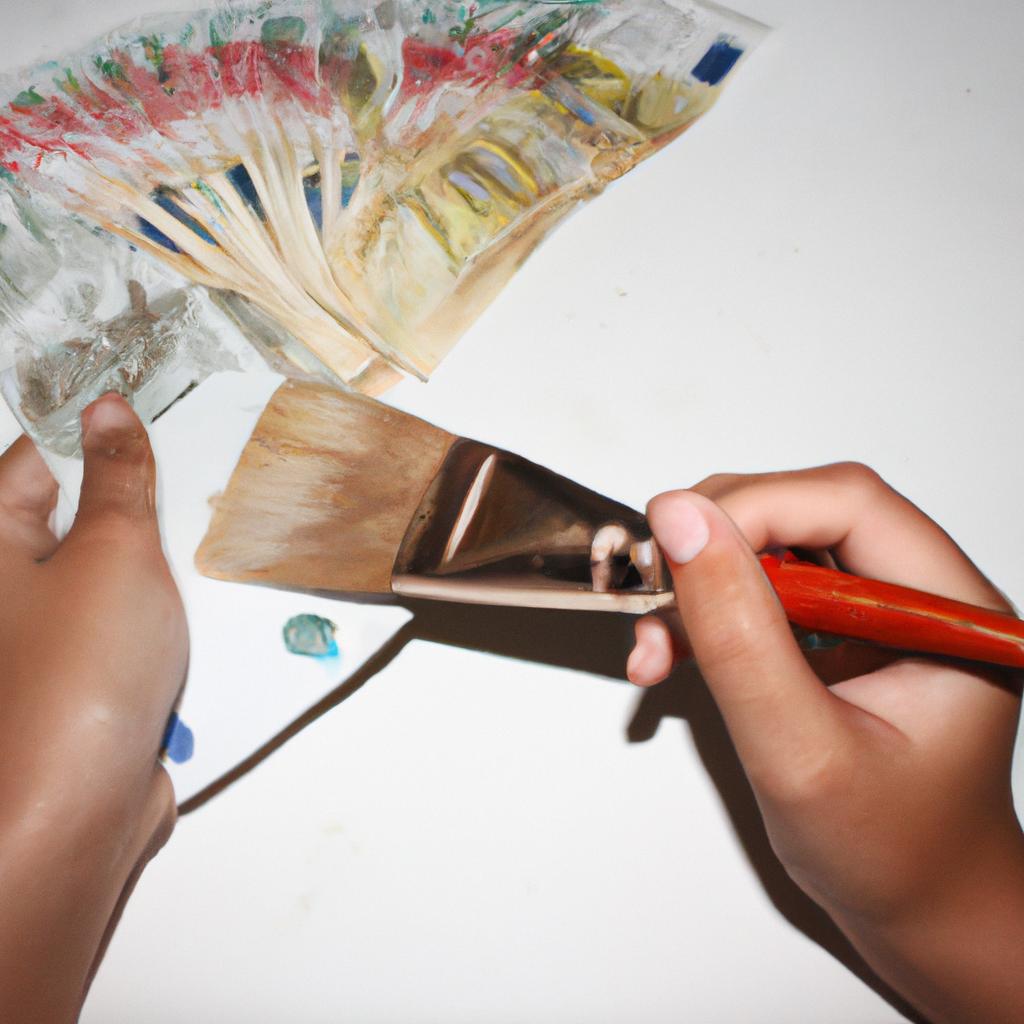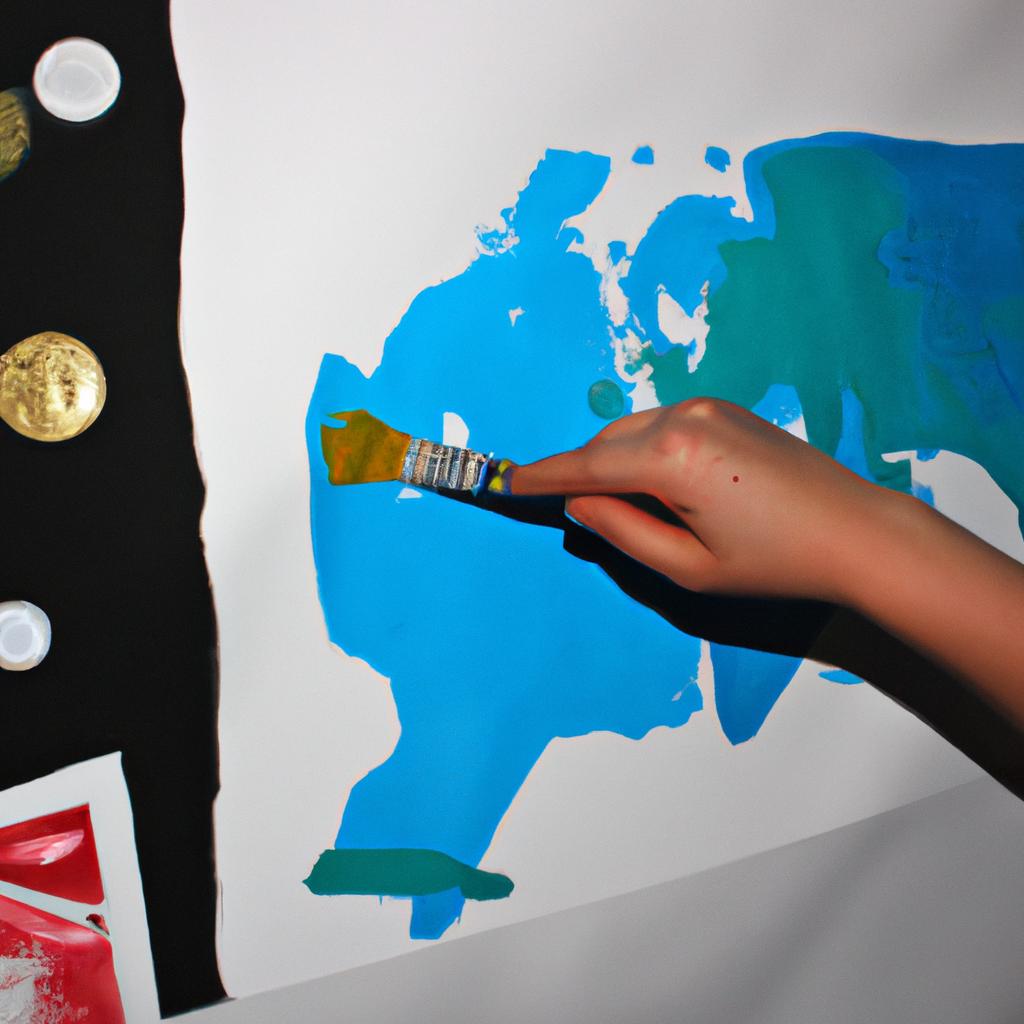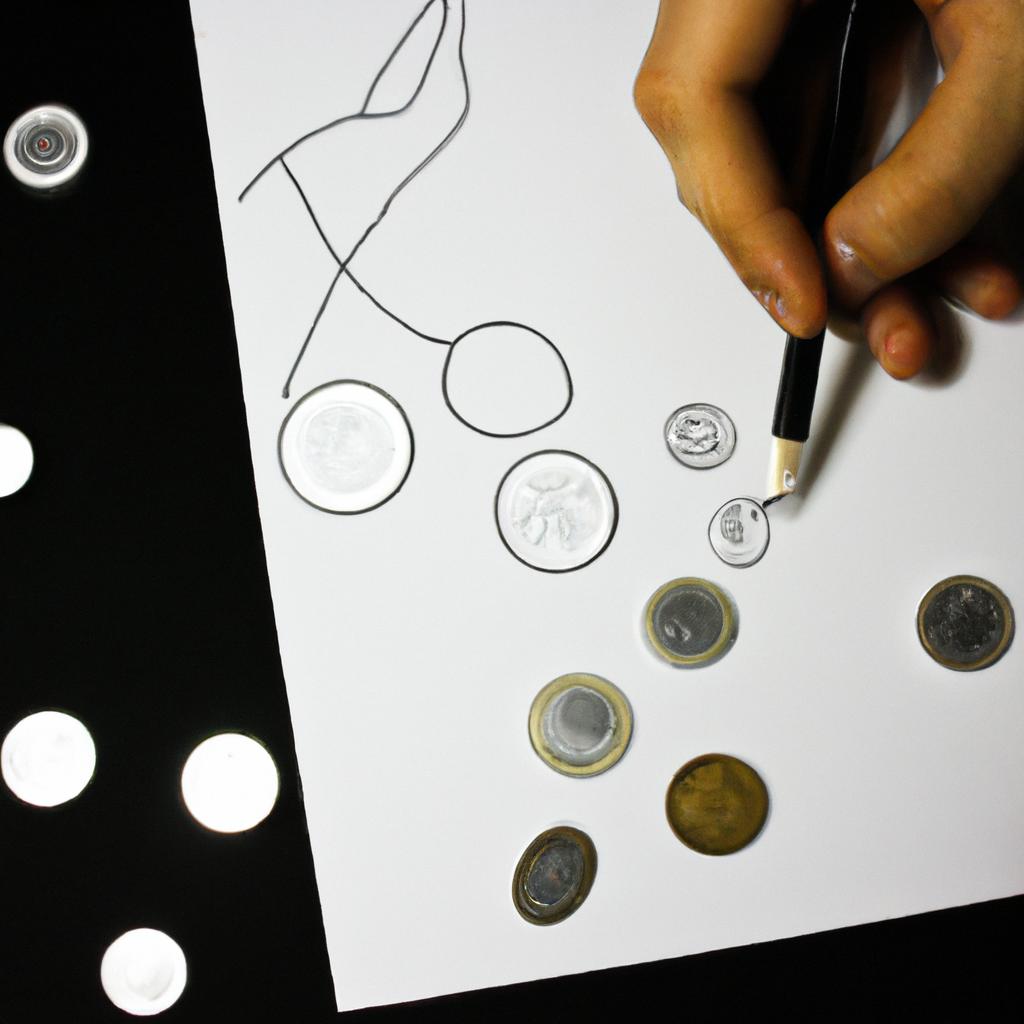Art investment has become increasingly popular in recent years as individuals seek alternative ways to diversify their portfolios and potentially generate significant returns. This article explores the various strategies that can be employed when investing in arts and illustration, with a focus on creative finance approaches. By examining case studies and hypothetical examples, this study aims to provide valuable insights into the potential benefits and risks associated with art investments.
One example of a successful art investment strategy is the acquisition of an original painting by a renowned artist early in their career. For instance, consider the case of a young illustrator whose work shows immense promise but has yet to gain widespread recognition. By recognizing the talent and potential value of their artwork, an astute investor could purchase several pieces at a relatively low cost. As the artist’s reputation grows over time, the value of these artworks may significantly appreciate, resulting in substantial financial gains for the investor.
However, it is important to note that art investment carries inherent risks due to its subjective nature and reliance on market trends. Therefore, investors must carefully assess factors such as an artist’s track record, market demand for their works, and overall economic conditions before committing capital to any particular piece or collection. To navigate these challenges successfully, employing creative finance techniques tailored specifically to the art market is crucial.
One creative finance technique that can be employed in art investment is fractional ownership. This approach involves dividing the ownership of a valuable artwork into shares, allowing multiple investors to collectively own and profit from the piece. Fractional ownership not only lowers the entry barrier for individual investors but also spreads the risk across a group of participants. Additionally, it provides an opportunity for art enthusiasts who may not have sufficient capital to invest individually to still benefit from potential appreciation in value over time.
Another strategy is investing in themed collections or series. Instead of focusing on individual artworks, investors can identify artists who create cohesive bodies of work centered around specific themes or concepts. By acquiring multiple pieces from these artists, investors can leverage the cumulative impact of their artistic vision and narrative, potentially increasing both aesthetic and financial value. This approach allows for diversification within a particular artist’s portfolio and may enhance market appeal.
Furthermore, engaging with emerging artists through mentorship programs or artist residencies presents an alternative form of art investment that goes beyond monetary returns. By providing support and resources to talented individuals early in their careers, investors can contribute to their growth while having access to exclusive works at preferential prices. This strategy offers the potential for long-term relationships with artists whose reputations may skyrocket in the future.
In conclusion, creative finance techniques tailored specifically to the art market can greatly enhance an investor’s chances of success when investing in arts and illustration. Fractional ownership, investing in themed collections or series, as well as engaging with emerging artists through mentorship programs are all viable strategies that offer potential benefits beyond traditional investment approaches. However, it is essential for investors to conduct thorough research and due diligence before committing capital to any art investment opportunity, considering factors such as an artist’s track record, market demand, economic conditions, and personal preferences.
Understanding the Art Market
The art market is a complex and dynamic industry that encompasses various forms of artistic expression, including painting, sculpture, photography, and illustration. It serves as a platform for artists to showcase their creations while offering investors an opportunity to acquire assets with potential financial returns. To truly comprehend the nuances of the art market, it is important to explore its key characteristics and factors that influence its value.
One real-life example illustrating the volatile nature of the art market is the case of Jean-Michel Basquiat’s artwork “Untitled.” In 1982, this vibrant graffiti-style painting was purchased for $19,000 by collector Jerry Saltz. Fast forward to 2017 when Japanese billionaire Yusaku Maezawa acquired it at auction for a staggering $110 million. This exponential increase in value over time highlights how art can serve as an investment vehicle capable of generating substantial profits.
When considering investing in art, several crucial aspects come into play:
-
Rarity: The scarcity or limited availability of a particular artwork contributes significantly to its value. Pieces created by renowned artists who produced only a small number of artworks during their lifetime tend to be highly sought after due to their rarity.
- Limited supply creates exclusivity
- Exclusivity fuels demand
- Demand drives up prices
- High price tags reflect scarcity and desirability
-
Artist Reputation: An artist’s reputation plays a pivotal role in determining the worth of their work. Established artists with long-standing careers and consistent recognition from critics and institutions are more likely to command higher prices compared to emerging talents.
-
Historical Significance: Artworks that have historical significance or cultural relevance often carry greater value within the art market. These pieces possess intrinsic qualities that transcend mere aesthetic appeal, making them desirable acquisitions for collectors seeking works with enduring importance.
-
Condition: The condition of an artwork affects its monetary value considerably. Well-preserved pieces with minimal damage or restoration tend to fetch higher prices, as they retain their original integrity and aesthetic appeal.
By comprehending these factors, art investors can gain a deeper understanding of the intricacies involved in assessing an artwork’s value. In the subsequent section on “Identifying Potential Investment Opportunities,” we will explore how one can leverage this knowledge to identify lucrative avenues for investment within the art market.
Identifying Potential Investment Opportunities
As we delve deeper into the world of art investment, it is essential to understand the dynamics of the art market. This section will explore key factors that influence this unique marketplace and shed light on its intricacies.
To illustrate these concepts, let’s consider a hypothetical scenario. Imagine an up-and-coming illustrator who has recently gained recognition for their distinct style and innovative approach. Galleries are starting to take notice, and there is growing buzz surrounding their work within the art community. In this case, understanding the art market becomes crucial in evaluating potential investment opportunities.
Firstly, one must grasp the concept of supply and demand within the art market. The scarcity of certain artworks can significantly impact their value. For instance, limited edition prints or pieces from artists with a small body of work tend to be highly sought after by collectors. Additionally, economic trends and shifts in taste can also affect demand patterns within the market.
Secondly, examining historical data and trends can provide valuable insights when identifying potential investment opportunities. Analyzing sales records at auctions or tracking prices over time allows investors to identify emerging talents or detect shifts in popularity for certain artistic styles. By studying past performance indicators such as price appreciation and exhibition history, investors gain a better understanding of an artist’s trajectory.
Lastly, keeping abreast of current events within the arts industry is paramount. Factors like critical acclaim, awards won, or gallery representation can greatly influence an artist’s reputation and subsequently impact their artwork’s value. Staying informed about upcoming exhibitions or collaborations helps investors anticipate future developments that may contribute to an artist’s rising profile.
In summary, comprehending how various elements shape the art market is fundamental for making informed investment decisions. Understanding supply and demand dynamics, analyzing historical data and trends, as well as staying updated with current events all play pivotal roles in identifying promising investment opportunities in arts and illustration.
Next section: Evaluating the Artist’s Reputation and Track Record. By evaluating these aspects, investors can gain further insights into an artist’s potential for long-term success and financial growth.
Evaluating the Artist’s Reputation and Track Record
In the world of art investment, it is crucial to identify potential opportunities that not only align with your financial goals but also have the potential for growth and appreciation. By carefully assessing various factors, you can make informed decisions about which artworks and artists are worth investing in.
To illustrate this process, let’s consider a hypothetical case study involving an emerging illustrator named Emma Thompson. Emma has recently gained recognition for her unique style and has been receiving positive reviews from both critics and collectors. She has exhibited her work at several prestigious galleries and has already sold a significant number of pieces.
When evaluating potential investment opportunities in the field of illustration, there are several key aspects to consider:
- The artist’s reputation: Investigate the artist’s background, education, awards, and past exhibitions to gauge their standing within the industry.
- Market demand: Analyze the current market trends and assess whether there is a growing interest in similar illustrative styles or themes.
- Artistic style: Consider whether the artist’s style resonates with your personal taste and if it demonstrates innovation or uniqueness compared to other artists working in similar genres.
- Long-term viability: Assess the sustainability of the artist’s career by examining their portfolio diversity, future projects or collaborations they may be involved in, and any upcoming exhibitions or events where their work will be showcased.
By conducting thorough research on these aspects, investors can gain valuable insights into an artist’s potential for success and decide if investing in their artwork aligns with their overall strategy.
Table – Factors to Consider When Evaluating Potential Investment Opportunities:
| Factor | Description |
|---|---|
| Artist’s Reputation | Evaluate educational background, awards received, past exhibitions |
| Market Demand | Analyze current trends; determine if there is growing interest |
| Artistic Style | Assess uniqueness/innovation compared to others |
| Long-term Viability | Evaluate portfolio diversity, ongoing projects/collaborations, future exhibitions or events |
By carefully considering these factors and conducting due diligence, investors can make well-informed decisions when it comes to identifying potential investment opportunities in the field of arts and illustration.
Understanding how to evaluate an artist’s reputation and track record is essential for successful art investments. In the following section, we will delve into this topic further and explore different strategies for assessing an artist’s credibility before making investment decisions.
Diversifying Your Art Portfolio
Investing in art requires a thorough evaluation of an artist’s reputation and track record. By understanding their past achievements and market presence, investors can make informed decisions on which artists to support financially. For instance, let us consider the case of renowned artist Jane Smith. With numerous solo exhibitions at prestigious galleries worldwide and her works being collected by prominent museums, Smith has established herself as a leading figure in contemporary illustration.
When evaluating an artist’s reputation and track record, several factors should be considered:
- Exhibition History: A strong exhibition history demonstrates an artist’s visibility within the art world. Solo shows at reputable galleries or participation in curated group exhibitions indicate recognition from curators, collectors, and critics alike.
- Awards and Recognition: Artists who have been acknowledged with awards or grants for their work often possess exceptional talent and potential for future success. These accolades serve as indicators of quality and may contribute to increased demand for their artwork.
- Sales Records: Analyzing an artist’s sales records provides insights into their market performance. Consistent sales at auction houses or through gallery representation can suggest sustained interest in the artist’s work.
- Critical Reception: Positive reviews by art critics lend credibility to an artist’s practice, indicating that their work is intellectually engaging or visually compelling.
Considering these factors will assist potential investors in making informed decisions about supporting artists whose careers show promise.
To further illustrate this point, let us examine a comparison between two hypothetical illustrators – John Davis and Sarah Johnson – using a table format:
| Criteria | John Davis | Sarah Johnson |
|---|---|---|
| Exhibition History | Several local exhibitions | International solo shows |
| Awards and Recognition | None | Winner of multiple industry awards |
| Sales Records | Limited online sales | Consistent sales through galleries |
| Critical Reception | Mixed reviews | Positive feedback from critics |
From this comparison, it becomes evident that Sarah Johnson has a stronger reputation and track record as an illustrator. Her international solo shows, industry awards, consistent sales through galleries, and positive critical reception all contribute to her standing within the art community.
By evaluating an artist’s reputation and track record based on these criteria, investors can make more informed decisions regarding potential investment opportunities. In doing so, they increase their chances of supporting artists who have demonstrated past success and show promise for future growth.
Transitioning into the next section about Monitoring Market Trends and Artistic Movements:
Understanding an artist’s reputation is crucial when investing in art; however, it is equally important to monitor market trends and artistic movements. By staying abreast of evolving tastes and preferences in the art world, investors can adapt their strategies accordingly to maximize returns on their investments.
Monitoring Market Trends and Artistic Movements
As we explore the world of art investment strategies, it is crucial to stay informed about market trends and artistic movements. By monitoring these factors, investors can make well-informed decisions to maximize their returns. This section will delve into the importance of staying updated with market dynamics and how it can impact your art portfolio.
Market trends and artistic movements play a significant role in determining the value of artworks. Let’s consider an example where contemporary abstract paintings have been gaining popularity among collectors recently. Artists like Jackson Pollock and Mark Rothko are highly sought after, resulting in a surge in prices for their works. Being aware of this trend allows investors to identify potential opportunities for growth within their portfolios.
To effectively monitor market trends and artistic movements, consider the following key points:
- Stay connected with reputable galleries, auction houses, and art fairs that showcase emerging artists.
- Follow art publications, online platforms, and social media accounts dedicated to discussing current trends in the art world.
- Engage with experts such as curators or art advisors who possess deep knowledge regarding shifts in artistic preferences.
- Attend industry events like seminars or conferences focused on analyzing market data and insights.
In addition to keeping track of market trends, investors should also pay attention to various artistic movements prevalent in today’s society. These movements often influence collectors’ tastes and preferences, thereby impacting the demand for specific types of artwork. To illustrate this point further, let us examine a table showcasing some influential artistic movements along with notable artists associated with each movement:
| Artistic Movement | Notable Artists |
|---|---|
| Impressionism | Claude Monet |
| Cubism | Pablo Picasso |
| Pop Art | Andy Warhol |
| Surrealism | Salvador Dalí |
By understanding the historical context behind these movements and recognizing their significance in the art world, investors can anticipate potential shifts in market demand and adjust their portfolios accordingly.
In conclusion, closely monitoring market trends and artistic movements is essential for successful art investment. By staying connected with relevant industry sources, engaging with experts, and analyzing influential artistic movements, investors can make informed decisions to enhance their portfolio’s performance.
Transition into subsequent section:
As we move forward in our exploration of effective art investment strategies, it becomes crucial to establish a long-term investment plan that aligns with your financial goals. Let us now delve deeper into understanding the importance of developing such a plan and how it can significantly impact your overall success as an art investor.
Establishing a Long-Term Investment Plan
Building on the importance of monitoring market trends and artistic movements, this section will delve further into how investors can stay informed in order to make strategic decisions. By understanding the ever-changing landscape of the art industry, investors can position themselves for long-term success.
In today’s competitive art market, staying ahead requires a keen eye for emerging talent and evolving trends. For instance, let us consider the case study of Jane, an aspiring investor with a passion for contemporary illustration. She noticed a growing interest in graphic novels and decided to focus her investments in this niche area. This decision proved fruitful as she observed an increasing demand for original artwork from popular graphic novel series, leading to significant returns on her investment.
To effectively monitor market trends and artistic movements, here are some key strategies that investors should consider:
- Engage with art communities online: Participating in forums and social media groups dedicated to arts and illustration allows investors to connect with artists directly, gain insights into their creative processes, and identify potential rising stars.
- Attend exhibitions and fairs: Visiting local galleries, art fairs, and exhibitions provides firsthand exposure to new artworks while networking with industry professionals who can offer valuable guidance.
- Follow reputable art publications: Subscribing to renowned art magazines or websites keeps investors up-to-date on current news, artist profiles, and critical analysis of emerging trends.
- Collaborate with experts: Seeking advice from curators, gallery owners, or consultants specializing in specific areas like graphic novels ensures access to specialized knowledge that may inform investment decisions.
| Strategy | Benefits |
|---|---|
| Engaging online | Direct connection with artists |
| Insights into creative process | |
| Identification of rising talents | |
| Attending events | Exposure to new artworks |
| Networking opportunities | |
| Following publications | Access to current news and artist profiles |
| Critical analysis of emerging trends | |
| Collaborating | Access to specialized knowledge |
By staying informed through these strategies, investors can gain a deeper understanding of the ever-evolving art market. This knowledge empowers them to make well-informed investment decisions based on both financial considerations and artistic potential. In this way, they can navigate the complexities of the art world with confidence, maximizing their chances for long-term success.
Please let me know if there is anything else I can assist you with!
 PSP Oste
PSP Oste



